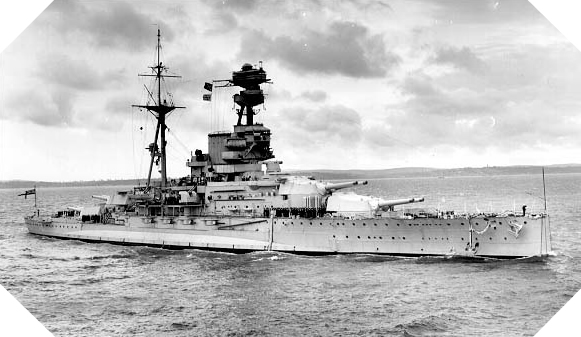HMS Ramillies
Index of Allied ships during Operation Neptune
History, technical specifications and photo

HMS Ramillies history
The battleship HMS Ramillies, launched on 12 June 1916 during the First World War, entered active service on 1 September 1917. It joined the 1st Squadron and took part in the final months of the war.
In 1920, it was deployed in the Sea of Marmara and bombarded Turkish positions during tensions between Turkey and Great Britain. The Ramillies was subsequently deployed in the Atlantic and again in the Mediterranean.
Modernised between June 1932 and August 1934 in the port of Plymouth, it was already ageing when the Second World War broke out in Europe. Deployed in Scandinavian waters, it returned to the Mediterranean in September 1939 to escort troop convoys to Egypt, before being transferred to the Indian Ocean to carry out new escort missions.
Deployed once again in the Mediterranean in June 1940 when Italy entered the war, she was engaged by Italian naval forces on 27 November of the same year but repelled the attack. Her next mission took her to the Atlantic and on 8 February 1941, she prevented a German attack on a British convoy by her mere presence. In March 1942, the Ramillies returned to the Indian Ocean and a major naval battle took place on 29 May against several Japanese submarines. Seriously damaged (the Japanese declared it sunk), it had to be repaired and did not return to service until June 1943.
HMS Ramillies opens fire on German positions on 6 June 1944. Photo: IWM
Present in the English Channel in the spring of 1944, it took part in Operation Neptune as part of Bombardment Force D, which operated off Sword Beach. It opened fire on the Benerville battery (Mont Canisy), destroying four of the six 155 mm guns after 80 minutes of engagement. The two remaining guns were destroyed in the evening. On the same day, two German warships fired five torpedoes at it but missed. At nightfall, HMS Ramillies crossed the English Channel to be resupplied in Portsmouth on 7 June and returned to action off the coast of Normandy the following day.
HMS Ramillies opens fire on German positions on 6 June 1944. Photo: IWM
During the days following Operation Overlord, it bombarded German positions (silencing a mobile battery on 17 June) and supported the advance of Anglo-Canadian ground forces with its firepower. It destroyed the railway networks in the Caen area while regularly coming under German attack: on 9 June, it prevented an E-Boote raid; on 12 June, it was missed by Luftwaffe pilots; and on 15 June, it was targeted by a German battery that fired 32 shells in its direction, two of which hit it and wounded a crew member. In total, the Ramillies fired 1,002 381 mm shells during the Battle of Normandy, the largest bombardment carried out by a warship at that time.
In August 1944, it was deployed in the Mediterranean as part of the Provence landings and, in particular, during Operation Dragoon to silence the German batteries in Toulon.
Placed in reserve on 31 January 1945, it was sold the following year: one of its 381 mm guns is kept at the Imperial War Museum in London, while its conning tower is on the HMCS Star in Hamilton, Canada.
HMS Ramillies technical specifications
Country of origin/use: Great Britain
Name: 07 – H.M.S. Ramillies
Class: Revenge-class battleship
Crew: 950 sailors
Armament (1944): 8 x 381 mm guns, 12 x 152 mm guns, 8 x 102 mm guns, 16 x 40 mm anti-aircraft guns, 8 x 20 mm anti-aircraft guns, 4 x 533 mm torpedo tubes
Displacement: 10,450 tonnes (in combat order)
Speed: 31.5 knots
Length: 190 m
Beam: 18.9 m
Draught: 8.8 m


